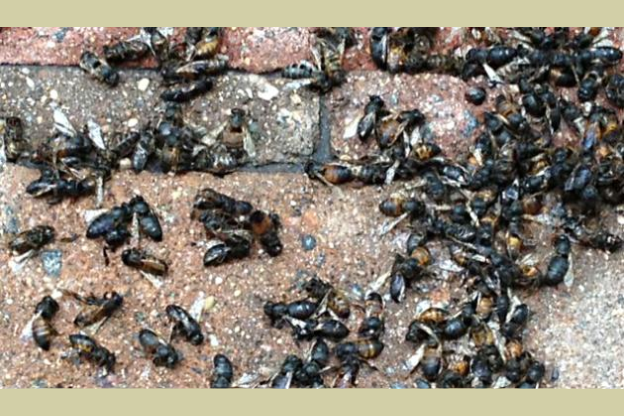
Killing bees and butterflies
Update on July 24th from Steve: Here’s a new article on subject of the great bee die off, and things seem pretty dire.
Last Friday’s Star Tribune reports that the monarch butterfly population is at an all time low this year citing the factors of last year’s drought and loss of habitat as the culprits. There may be other factors at work, too.
The same issue of the paper includes a review of More than Honey, a documentary concerning the world-wide collapse of the honey bee population. Most articles that you read about this cite a combination of factors for this phenomenon, including loss of habitat, weakened immune systems of the bees and use of neonicotinoid type pesticides.
Two 2012 studies, which were published in the journal Science, have linked these pesticides to bee decline. According to an article in the New York Times, neonicotinoids are taken up by plants and moved to all their tissues — including the nectar on which bees [and butterflies, too] feed. The article goes on to state that the concentration of neonicotinoids in nectar is not lethal, but some scientists have wondered if it might still affect bees.
The movie review mentions that honeybees are trucked from field to field to pollinate crops of pesticide laden food. It continues with a comment from Fred Terry (an Arizona apiarist) who remarks -South American “killer bees” may be our best hope for disease-resistant bee colonies in the future.
This year the EU decided that their best hope was to sharply restrict the use of neonicotinoid pesticides. The suspension was proposed after the European Food Safety Authority concluded in January that three neonicotinoids – thiamethoxam, clothianidin and imidacloprid – posed an unacceptable risk to bees. The three pesticides will be banned from use for two years on flowering crops such as corn, oilseed rape and sunflowers, upon which bees feed.
It is estimated that one-third of our diet is dependent on pollinators. In June of this year, a letter was sent to President Obama urging him to suspend the use of these EPA-approved neonicotinoid insecticides: imidacloprid, clothianidin, thiamethoxam, dinetofuran and acetamiprid. The letter is signed by twelve environmental groups including the American Bird Conservancy, Center for Environmental Health, Defenders of Wildlife, Sierra Club, and the Xerces Society.
Perhaps the European ban will provide some insight into the effect of these pesticides on pollinators, and perhaps there will be some preventative action taken in the United States. What else can be done?
From the Star Tribune article regarding monarchs…
Vera Krischik, a University of Minnesota entomology professor, added that the absence of monarchs is part of a larger, more disturbing picture. Honeybees, bumblebees, parasitic wasps and many other kinds of beneficial, pollinating insects — including other butterflies — are also noticeably absent this year.
…Krischik said it’s not just agriculture that has reduced the milkweed and other flowering weedy plants that pollinating insects need for nourishment.
She said it’s also back-yard gardeners with a preference for flowering but sterile, non-seed-producing plants. Butterflies no longer can find as much food in a back yard as they once could, she said.
“We have met the enemy, and he is us,” Krischik said.
There are things that gardeners and landscapers do to help with habitat.
The Xerces Society is a nonprofit organization that protects wildlife through the conservation of invertebrates and their habitat. Its website states that for forty years, the Society has been at the forefront of invertebrate protection worldwide, harnessing the knowledge of scientists and the enthusiasm of citizens to implement conservation programs. It has published Attracting Native Pollinators: Protecting North America’s Bees and Butterflies which provides information on providing flowering habitat and nesting sites.
The Minnesota DNR has published Landscaping for Wildlife, a guide which (according to their site) will show you how to attract wildlife (“everything from butterflies to deer, cardinals to wood ducks”) to your property using inexpensive, easy-to-follow landscaping plans.
In the meantime, here’s a horrific irony for you about killing bees on purpose.
Thanks for your feedback. If we like what you have to say, it may appear in a future post of reader reactions.


